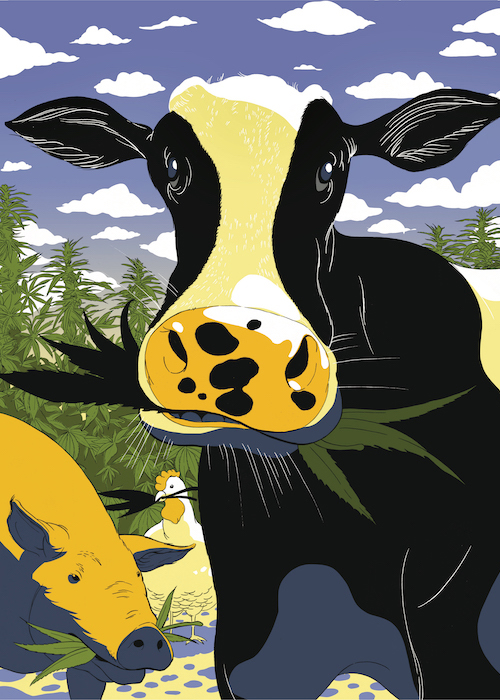
- Cann Society News
-
by ADMIN BKK
Hemp cultivators are bringing full-spectrum hemp into traditional agriculture and onto your table.
Prior to the demonization of all-things-cannabis in the United States, hemp grew freely across North America. Animals, both wild and domesticated, could graze on naturally growing hemp before the plants were largely eliminated from the landscape under federal prohibition.
But today, hemp as a nutritional supplement for animals is starting to return to the United States in interesting ways. There are a myriad of companies selling CBD products for pets, claiming that dogs and cats will gain the same benefits as humans from the cannabinoid, despite the lack of conclusive studies. A few pet food companies are also starting to offer treats and daily foods featuring full-spectrum hemp to supply proteins, amino acids, omega-3s and omega-6s. Perhaps most interesting, traditional agriculture is beginning to turn to hemp to supplement the diets of livestock to increase health, weight and in the end profits.

Like many areas of hemp cultivation, production and legislation, Colorado is leading the charge. In March 2017, Colorado Governor John Hickenlooper signed a bill to create a working group under the Commissioner of Agriculture to study the feasibility and benefits of hemp as animal feed. Since then, ranchers in Colorado have begun to introduce hemp to their livestock’s foodstuffs.
Because of its proteins, beneficial fatty acids and overall cannabinoid profile, hemp-derived food offers an array of nutritional benefits for animals consuming it.
“We’ve been adding about 10 percent to 20 percent of our pelletized hemp to feed for cattle and pigs,” says Pauli Roterdam of Endo Scientific, a hemp-based tincture company, and Audacious Farms, an organic urban farm in Denver, Colorado growing produce and hemp. “No one should ever feed their animals just everything hemp. It’s a supplement. What we’ve seen are healthier animals going for 10 to 20 percent more at auction. Their coats look better. They weigh more. And that’s just from four months on our hemp feed.”
And because these animals are being reared for eventual human consumption, Roterdam says some of those benefits are passed down to the end consumer. Basically, eating meat from healthier animals is good for whomever consumes that animal.
“We think we’re going to establish even more rare cannabinoid contents, returning the waste and regenerative qualities back to the soil, which adds more value to our animals, soil and people, returning hemp and CBD to our diet the way it was 100 years ago,” says Roterdam.
Hemp is also being used as a supplement for chickens and ducks at Enlita Farms, a Longmont, Colorado-based multipurpose farm. Because its poultry are consuming hemp, the eggs that Enlita Farms produces contain higher levels of omega acids, amino acids, vitamins and cannabinoids, says Roterdam.
It’s an interesting development to see Colorado and others considering integrating hemp into the diet of livestock. For most of the food-concerned public, it seems the thinking has focused on humans eating different parts of the hemp plant for its nutritional benefits. But ultimately, the most complete way to reintroduce hemp to our diets involves feeding our livestock hemp, bringing the traditional diet full circle to reap the nutritional benefits of a plant that Americans who came before us consumed.
Reference
https://cannabisnow.com/the-future-of-hemp-fed-meat/?fbclid=IwAR20vNjpH9BxpIvrLtqq0qqBkUTzOU6wSaRRRM6WIjBiU52p3wvMJocXfdE





